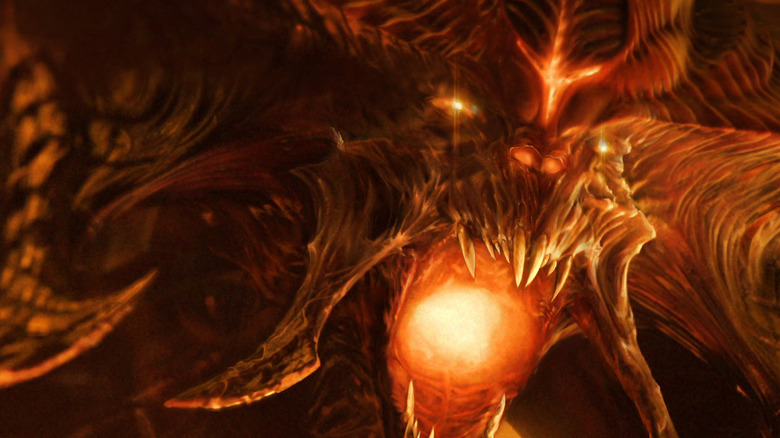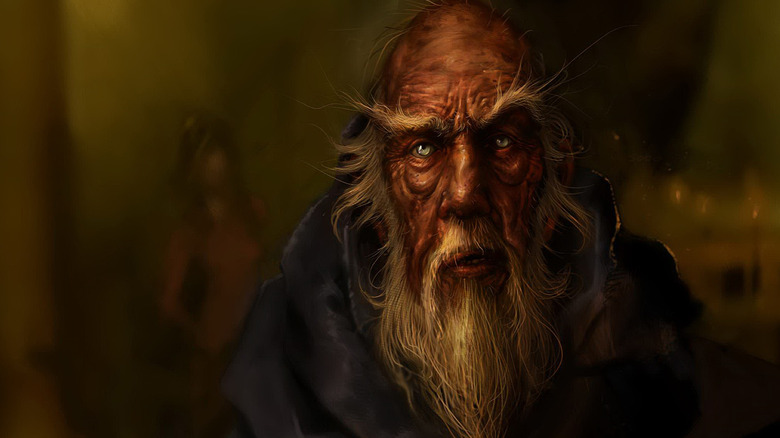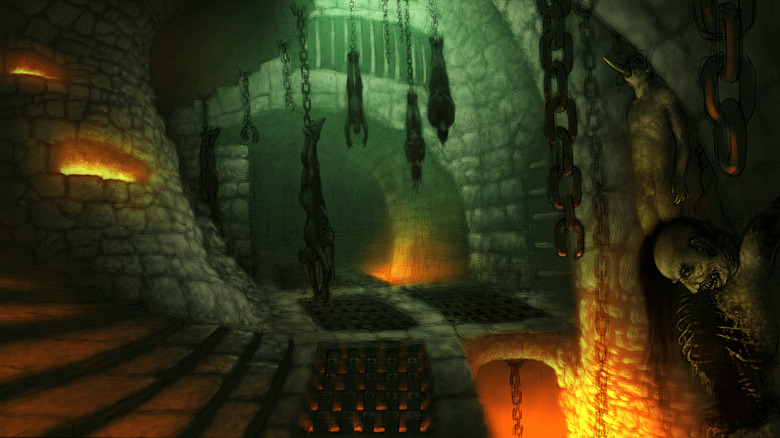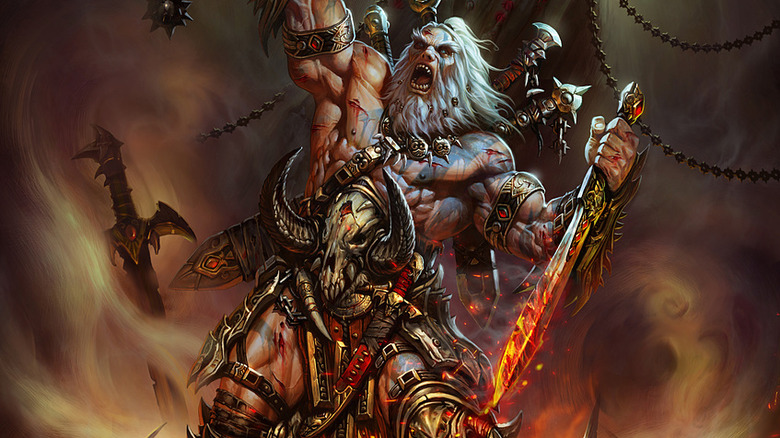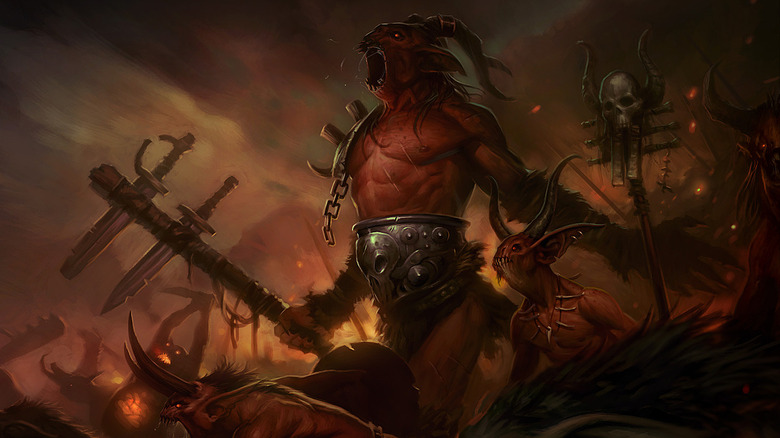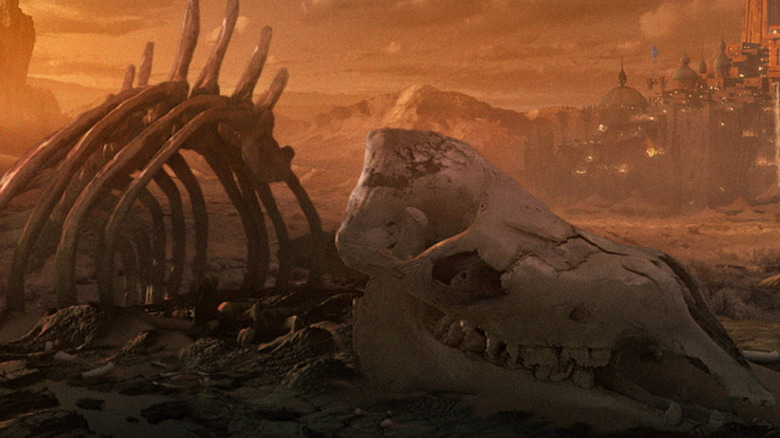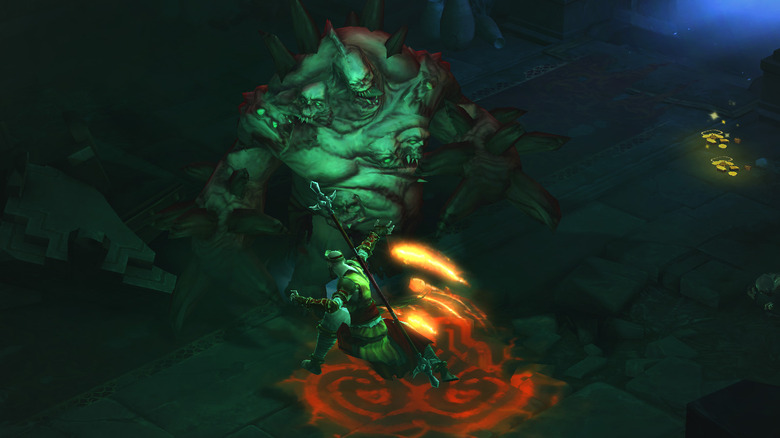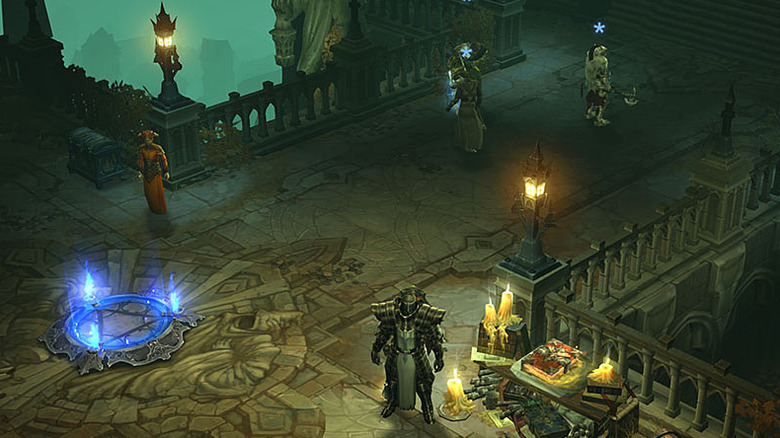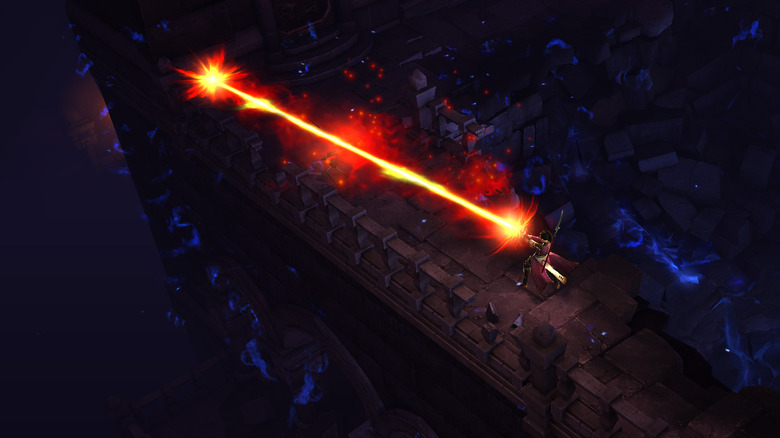The Untold Truth Of Diablo
The Diablo series is one of Blizzard's most recognizable properties. It is set in a very different universe than the lighter-hearted fantasy realm of Warcraft, the over-the-top science fiction of StarCraft, or the bright and colorful world of Overwatch. The Diablo series is bleak, dark, and unforgiving, and it has definitely left its mark on gaming, influencing titles from all over the spectrum: for example, Forbes writer Paul Tassi has repeatedly argued that Destiny 2 is just a Diablo game in a different wrapping paper.
The randomized loot. The insane level of customization. That MUSIC. The Diablo series has something to appeal to nearly every type of gamer out there, which makes it easy to understand why it has endured for so long with only three true entries in the series. Venture Beat wrote in 2016 that the series had sold almost 25 million copies, and there is certainly more gas in the tank for Diablo. Today, we're exploring some of the lesser-known corners of the Diablo series. Stay awhile and listen.
Diablo's team was not the same team that made other Blizzard classics
It seems odd that the same development team that brought us Warcraft and StarCraft would completely change pace and bring us the darker-than-dark Diablo. Although both of those RTS series tell pretty heavy stories, they are loaded up with razor-sharp humor and more than a few winks to the audience. The original Diablo played it straight throughout (for the most part — more on that later), but that's because the team that developed it wasn't originally affiliated with Blizzard at all.
The original pitch for Diablo is available for anyone to look at online, and it comes from a company called Condor. Condor got its feet wet with a few console games like NFL Quarterback Club '96 and Justice League Task Force before putting together the design for what would become Diablo. Blizzard was so impressed with the direction of the game and studio that they not only agreed to publish Diablo, but also bought Condor and rebranded them as Blizzard North. Not a bad strategic move on their part at all.
The original pitch for Diablo was practically unrecognizable
Even though Condor was originally the brains behind Diablo, it's probably a good idea Blizzard flexed their muscles a bit and helped steer it in the right direction. If you read through the original pitch for the game, there are some pretty bizarre elements involved.
For one, the art style took inspiration from a rather strangemuse. PCGamesN wrote on a speech that David Brevik, the President of Condor when they partnered with Blizzard, gave at GDC 2016. Instead of the realistic 2D sprites that we know and love, Diablo was originally going for a claymation style look. Their inspiration? Dinosaur beat 'em up Primal Rage. Thank God that plan got dropped, since it would have been too much work for the small team.
Speaking of small teams, their original pitch accounted for an eleven-person team working for a single year. How times have changed.
There are plenty of other original design elements that were changed significantly, with perhaps the biggest being that the game was supposed to be turn-based in its early development. Considering the impact Diablo would go on to have on the action-RPG genre, that little tweak had a huge effect on video game history.
Diablo wants you to eat your vegetables
Diablo cut back on some of the silliness you can find in Blizzard's other titles, but there are still a few moments where the developers have a bit of fun with the dark, gothic atmosphere. One such example comes when you enter the final level of the first game, when the Dark Lord himself, Diablo, calls out a demonic greeting to you.
It is a bit shocking when it occurs; no other level in the game has featured something like this. Diablo must mean business: he sounds evil, otherworldly, and far more dangerous than the hordes of demons you have encountered already. In reality, he just isn't sure how to communicate with you. Play his ominous sounding words backwards, and you'll see Diablo is just looking out for you. He says, "Eat your vegetables and brush after every meal."
Huh. Kinda changes the whole dynamic of the game when you realize you're just fighting a wannabe dentist.
The player character had much more backstory
Diablo has a pretty bare-bones story. Sure, there is plenty of interesting lore to discover, and, as the game grew in popularity, more and more got filled in about different characters, places, and events. Overall, however, it essentially breaks down to: "These are monsters. Kill them." That wasn't always the case; Diablo originally was going to have a story driven much more by the player character, and it would allow the player to customize it even further than the release version allowed.
In his Diablo retrospective Stay Awhile and Listen, David Craddock mentions that Condor originally did not have class options, but would instead allow the player to adjust attributes however they desired. This could allow for hybrid classes, or allow for complete specialization in one area.
The original pitch for Diablo does not reflect that, instead describing a game with multiple classes. However, there was more customization allowed to players: they could choose a race for their character, each of which would offer certain benefits and disadvantages. There was also a bit of a story for the character: a family slain by bandits, a desire for revenge, and a furious, suicidal mission to destroy the Devil himself. Many of these elements were left on the cutting room floor for the final release.
The original game had a time limit that made the final boss extremely difficult
One of the best parts of Diablo is exploring every nook and cranny, cleaning out every monster on a given floor, and hunting for that perfect piece of gear to make your hero unstoppable. Originally, however, that was not the plan for the game's design. A little item called the "Map of the Stars" gave your playthrough a time limit that would make the final boss practically impossible to beat if you took too long getting to him. Thankfully, that item was cut from the final build.
Game Surge writes that the Map of the Stars item was hacked out of the game's data files, and that Blizzard has acknowledged the item's original intent. Blizzard cut the item because it discouraged players from exploring the world. Again, considering the impact that Diablo had on the world of RPGs and video games in general, this seems like another "Thank God they did that" choice in game design.
Blizzard took a fan rumor and made it real
Ah, the mythical cow level. One of the original Diablo's toughest to reach areas.
It was tough to reach because it never existed.
Rumors of a secret cow level began on forums and persisted through the entirety of the game's heyday, with all sorts of difficult and time-consuming methods of supposedly gaining access to it. If you could enter it, deadly cow enemies and all sorts of rare loot awaited you. Again, this was entirely imaginary; an early example of an internet meme gone viral.
Leave it to Blizzard to take an absurd idea and run with it.
Enter Diablo II, and you now could actually access a hidden cow level. Combine a tome of town portal with Wirt's Leg in the Horadric Cube, and a red portal would teleport you to a world of aggressive, bipedal cow enemies. These enemies were extremely difficult, and could quickly make mincemeat out of unprepared adventurers.
Not one to back away from a good joke, Blizzard has referenced the cow level for some time, including a version of it in Diablo III and even in World of Warcraft. No word on if Overwatch contains one.
Error 37 ushered in a new era of frustrating DRM problems
Diablo III was as hotly anticipated as a game can get, promising to take what we loved about the first two games and make it even bigger. However, the design choice of making the game an "always online" title and the insane levels of hype surrounding it came together to create a perfect storm of problems and make the Diablo III release one of the most memorable (in a bad way) releases in history.
Error 37.
The servers were completely overloaded when the game released, which caused gamers everywhere to frantically relaunch, reinstall, and bombard Blizzard with questions.
Error 37.
With the servers bogged down, no one was able to play the game. Venture Beat writes that, even for days after release, many customers were unable to get past the dreaded error message and start playing.
Error 37.
Memes were created. Fan backlash ensued. Diablo III, as detailed in several pieces like Jason Schreier's Blood, Sweat, and Pixels, literally took years to recover. Eurogamer writes that several companies contemplated removing planned "always online" features from their games due to the debacle that was "Error 37."
Blizzard eventually did right the ship with Diablo III, and many companies did actually learn from the disastrous release.
Diablo III was almost completely redesigned after its release
Diablo III had more problems at its launch than just the dreaded "Error 37" message. The online-only aspect bugged a lot of fans, but most could understand Blizzard's purpose in choosing to release the game the way it did. Fans soon ran into some other problems with the game's design, and they mostly revolved around the end-game grind.
Jason Schreier wrote in Blood, Sweat, and Pixels: "The difficulty ramped up way too fast. Legendary items dropped too infrequently. The end-game was too challenging. And, perhaps most frustrating of all, the loot system seemed to revolve around the in-game auction house, where Diablo III players could use real-life money to buy and sell powerful equipment."
Even though Diablo III had sold millions of copies, Blizzard knew it was not up to the quality standards they kept. They brought in a new lead designer, Josh Mosqueira, who had been working on a console port of the game, to overhaul several of the game's systems. Mosqueira brought in several features of the console port to help streamline Diablo III's first expansion, Reaper of Souls. That included eliminating the game's real money auction house.
He increased item drop rates, changed the way characters could move, and helped bring the fun back to Diablo III. A disastrous launch turned into a much loved game that is still played by thousands of people.
Diablo III has a few joke dungeons
From cow levels to hidden lore jokes, Blizzard has managed to sneak some humor into the otherwise gloom and doom world of Diablo. One of the most innovative ways they were able to do this was with two extremely rare dungeons hidden in Diablo III. "Development Hell" and "Quality Well" are ways of giving credit to Blizzard staff, and are both tough to find: they only appear on Nightmare difficulty or above, and they only have about a one percent chance to spawn.
Both levels look like ordinary dungeons, but every monster has the name of a Blizzard employee. "Development Hell" monsters are named after the Diablo III design team, and "Quality Well" monsters feature names of the QA team. These dungeons are a unique (and maybe cathartic, after the "Error 37" debacle) way to pay homage to the minds behind Diablo III. You can even get an achievement for working your way through "Development Hell" and taking out the unique boss, Josh Mosqueira.

